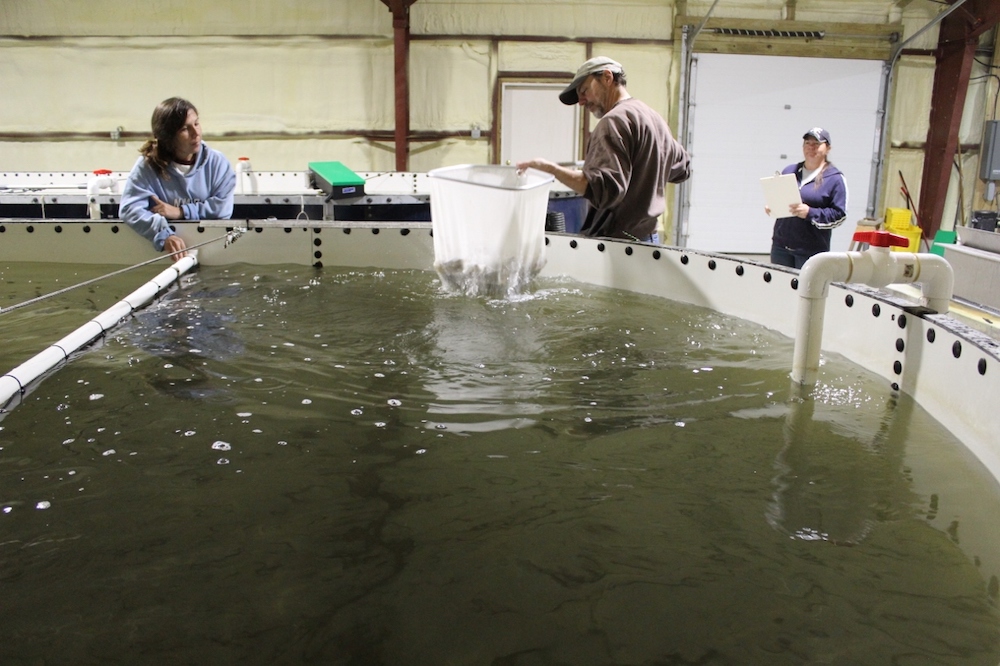
- Details
- By Chez Oxendine
- Food | Agriculture
Mi’kmaq Nation is casting a wider net — literally.
The tribe in northern Maine is embarking on a significant expansion of its fish hatchery, quadrupling production and aiming to reach customers from coast to coast. The ambitious tribal project goes beyond business, encompassing cultural revitalization, economic sovereignty, and contributing to a growing market for sustainable seafood.
This summer, the tribe’s Mi’kmaq Farms enterprise plans to break ground on a new 12,000-square-foot brook trout hatchery in Caribou, Maine. The expansion, partially funded by a $4 million grant from the federal Economic Development Administration (EDA), will expand the tribe’s existing hatchery facility as well as its staffing capacity.
The new hatchery will employ three people, up from one full-time employee and one part-time employee, according to Shannon Hill, the tribe’s environmental director. The expansion will also increase the hatchery’s capacity from two 16,000-gallon tanks to four 18,000 gallon tanks.
Expanding the hatchery will widen partnerships Mi’kmaq Farms can forge. The tribal enterprise has already received calls “from one coast to the other” inquiring about the hatchery’s brook trout, Hill told Tribal Business News.
“We've gotten calls from California (and) a company in New York City that wants to purchase our product and smoke it and sell it that way,” Hill said. “There’s this need and desire for Native brook trout out there.”
Brook trout has long been an important part of the tribe’s cultural traditions and subsistence. Right now, the hatchery produces around 12,000 pounds of brook trout each year. That’s enough to support some tribal members and donate to surrounding communities, Hill said. A small portion of the tribe’s fish can be sent to other parts of Maine.
To go from distributing around the state to around the country, Mi’kmaq Farms needed more space. The expanded hatchery could realistically produce between 35,000 to 40,000 pounds of trout per year, Hill said. That’s about what it would take to make orders large enough to consider shipping nationally.
“If we can pack larger quantities, the shipping costs become more reasonable,” Smith said. “Otherwise it gets expensive really fast.”
Market research firm MMR valued the global market for freshwater fish at $241 billion in 2023, driven by consumption in China, India, Japan and the rest of the Asian Pacific region. While those countries also dominate global fish hatchery production, the U.S. and Canadian markets for freshwater fish are gaining ground and expected to grow at a faster pace.
In the U.S. alone, freshwater fisheries generate more than $37 billion, with rapid growth in trout, catfish and tilapia as major farmed species, the MMR report notes.
With more tanks and more staff, the tribe will be able to compete year-round, Hill said. Right now, they are limited to harvesting fish once a year.
That’s important because the hatchery’s chief goal — even before economic development — is food sovereignty, Hill said. Mi’kmaq Farms originally opened the hatchery in 2014 in response to a dearth of safe fishing places for the tribe.
“We realized the need because all of the lakes and streams listed on Maine’s fish advisories were places we fished from. They were saying we could maybe eat one fish meal a month, which is not sustainable,” Hill said. “We said, well, maybe we should raise our own, and we found the funding and support. We’ve been very successful after that.”
The tribe initially planned to pay for the hatchery expansion with the $4 million EDA grant, Hill said. But rising construction costs brought the final total to an estimated $5.5 million, which meant seeking out private donations for the rest of the cost.
It should pay off threefold, Hill said.
“It's food sovereignty, it's economic development, it's workforce development,” Hill said. “Having more harvestable fish year-round just benefits the tribe.”
While the hatchery expansion is the biggest change coming to Mi’kmaq Farms, it isn’t the only one. The farm has recently added new outdoor crops to their selection, and plans to add more fruits later in the year.
At the center of the farm’s expansion, however, is a greenhouse that was completed last fall. That, too, fits into the tribe’s goal of food sovereignty, Hill said. Many Mi’kmaq members live far enough from most traditional grocery stores that Mi’kmaq Farms becomes a crucial source of fresh food. However, the farm’s location in Maine meant avoiding some necessary staple crops outside of a short growing season, Hill said.
The greenhouse gives a “two-month head start” on that growing season, which means multiple harvests of some crops, Hill said.
“We saw a need early on to supply fresh fruits and vegetables,” Hill said. “Especially in the winter, it’s difficult to get anything fresh. So we did what we could to meet that need.”
The greenhouse will support a new storefront at Mi’kmaq Farms opening in June. The fish hatchery expansion should be ready by January. The farm is going to continue providing jobs, food, and revenue for the tribe, Hill said.
“Things are going well,” Hill said. “We’ve got a lot of things here that we’re really proud of and really happy about.”
